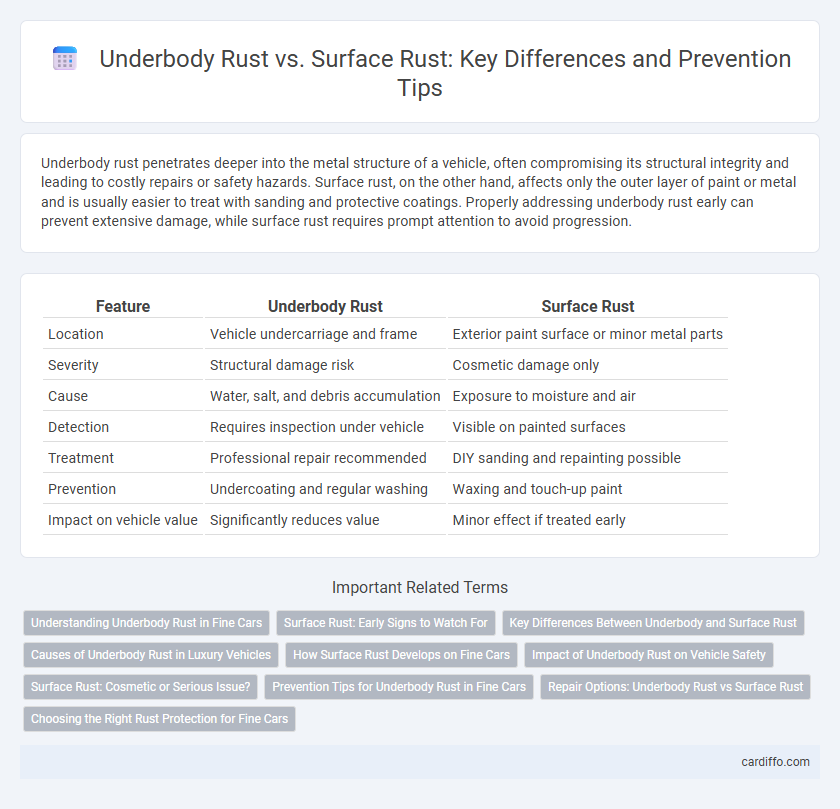Underbody rust penetrates deeper into the metal structure of a vehicle, often compromising its structural integrity and leading to costly repairs or safety hazards. Surface rust, on the other hand, affects only the outer layer of paint or metal and is usually easier to treat with sanding and protective coatings. Properly addressing underbody rust early can prevent extensive damage, while surface rust requires prompt attention to avoid progression.
Table of Comparison
| Feature | Underbody Rust | Surface Rust |
|---|---|---|
| Location | Vehicle undercarriage and frame | Exterior paint surface or minor metal parts |
| Severity | Structural damage risk | Cosmetic damage only |
| Cause | Water, salt, and debris accumulation | Exposure to moisture and air |
| Detection | Requires inspection under vehicle | Visible on painted surfaces |
| Treatment | Professional repair recommended | DIY sanding and repainting possible |
| Prevention | Undercoating and regular washing | Waxing and touch-up paint |
| Impact on vehicle value | Significantly reduces value | Minor effect if treated early |
Understanding Underbody Rust in Fine Cars
Underbody rust in fine cars occurs when corrosion penetrates the vehicle's structural components, compromising safety and integrity beyond the superficial damage of surface rust. High-performance and luxury vehicles often feature advanced coatings and rust-proofing treatments, but failure to address underbody rust can lead to costly repairs and decreased resale value. Regular inspections using lift platforms and rust converters help maintain the underbody's durability and preserve the vehicle's pristine condition.
Surface Rust: Early Signs to Watch For
Surface rust typically appears as small, orange or brown spots on the vehicle's paint or metal surfaces, especially around wheel wells, door edges, and under the chassis. Early signs include tiny bubbles under the paint or fine, rough patches where the metal looks dull or flaky, which indicate oxidation has begun but damage is still minimal. Spotting surface rust early allows for prompt treatment with rust converters or sealants, preventing progression to more severe underbody rust that compromises structural integrity.
Key Differences Between Underbody and Surface Rust
Underbody rust primarily affects the structural components of a vehicle, such as the frame and suspension parts, leading to potential safety hazards and costly repairs. Surface rust usually appears as minor oxidation on the exterior body panels, often limited to paint and metal surface damage without compromising structural integrity. The key difference lies in severity and location: underbody rust undermines vehicle stability, while surface rust mainly impacts aesthetics and can be treated with simpler methods.
Causes of Underbody Rust in Luxury Vehicles
Underbody rust in luxury vehicles primarily results from prolonged exposure to moisture, road salt, and debris, which accelerate metal oxidation beneath the chassis. Poor drainage systems and infrequent undercarriage cleaning exacerbate corrosion risks by trapping contaminants against the metal surfaces. Advanced protective coatings and regular maintenance are essential to prevent structural damage caused by underbody rust in high-end automobiles.
How Surface Rust Develops on Fine Cars
Surface rust develops on fine cars primarily due to exposure to moisture, oxygen, and salts, causing oxidation on the vehicle's paint or metal surfaces. This initial rust layer typically appears as small, reddish-brown spots that can form through chipped paint, scratches, or environmental contaminants settling on the car's exterior. Proper maintenance, including regular washing and applying protective coatings, can significantly slow the onset of surface rust.
Impact of Underbody Rust on Vehicle Safety
Underbody rust compromises the structural integrity of a vehicle's chassis and suspension components, significantly increasing the risk of mechanical failure and accidents. Unlike surface rust, which is primarily cosmetic and affects only the paint or metal surface, underbody rust corrodes critical areas such as frame rails, brake lines, and fuel tanks. This deeper corrosion weakens load-bearing parts and can lead to costly repairs or complete vehicle failure, posing a serious safety hazard.
Surface Rust: Cosmetic or Serious Issue?
Surface rust typically affects only the outer paint or metal layers, posing primarily a cosmetic concern rather than structural damage. It appears as orange or reddish spots on the vehicle's paint, easily treatable with sanding, priming, and repainting to prevent further progression. Unlike underbody rust, which can compromise frame integrity and safety, surface rust rarely impacts the vehicle's performance or longevity if addressed promptly.
Prevention Tips for Underbody Rust in Fine Cars
Underbody rust in fine cars develops from prolonged exposure to moisture, salt, and dirt, making early prevention critical to preserving vehicle integrity. Applying high-quality rustproof coatings, regularly washing the undercarriage, especially after winter or exposure to salt, and ensuring proper drainage in wheel wells significantly reduce rust formation. Routine inspections and timely repairs of chips or scratches in protective layers help maintain the vehicle's structural strength and resale value.
Repair Options: Underbody Rust vs Surface Rust
Repair options for underbody rust often require professional intervention involving sandblasting, rust converter application, and protective coatings to prevent structural damage. Surface rust repairs can be managed with sanding, rust inhibitors, and touch-up paint, suitable for minor, superficial corrosion. Choosing the correct repair method depends on rust severity, location, and extent of metal degradation, ensuring long-term vehicle integrity.
Choosing the Right Rust Protection for Fine Cars
Underbody rust penetrates deeply, compromising structural integrity, while surface rust affects only the outer metal layer, making fine cars more vulnerable to long-term damage if not properly treated. Selecting rust protection for fine cars requires durable underbody coatings with corrosion inhibitors and regular application of surface treatments that seal and prevent moisture infiltration. Opting for professional-grade rustproofing products tailored to fine car materials ensures optimal preservation and maintains vehicle value.
Underbody rust vs Surface rust Infographic

 cardiffo.com
cardiffo.com